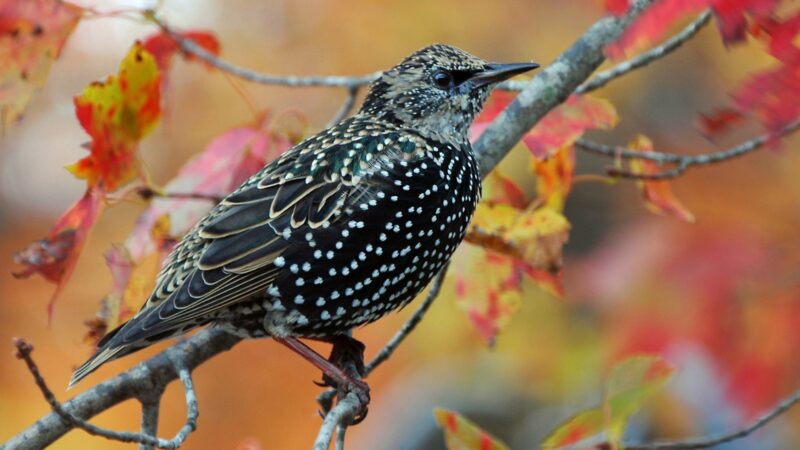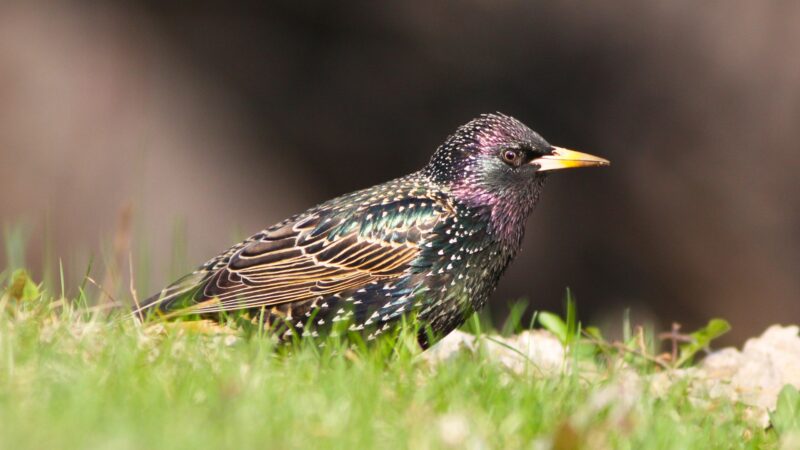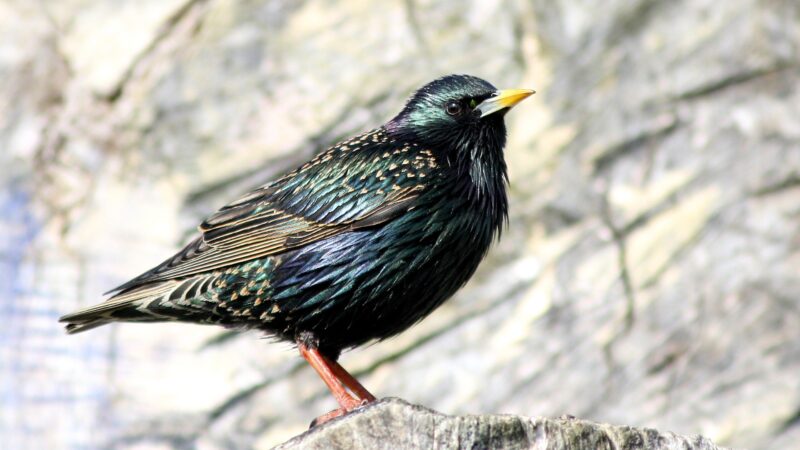European starlings are nuisance birds that can get quite invasive once they enter your property. It is common to encounter problems when dealing with these pests, which is why knowledge on how to properly and humanely get rid of them is essential.
So, how to get rid of starlings? You can employ humane exclusion methods, scaring tactics through the use of visual or auditory deterrents, removal of attractants such as nesting materials and food, and educating others.
This blog post will provide you with everything you need to know about European starlings, how to identify them, and solutions that could discourage them from ever entering your property. Read further for more!
Understanding European Starlings

European starlings (Sturnus vulgaris) are stocky-bodied birds that are similar in size with blackbirds and robins. They have an iridescent green plumage covering their napes, backs, and chest areas, short pink legs, long yellow beaks, and short and pointed wings that occasionally have flecks of purple and green.
During the winter, their plumage dulls to a brown or dusky black color, speckled with stark white or cream spots. Starlings average 21.5 centimeters in length, 70 to 100 grams in weight, and 40 centimeters in wingspan.
Starlings inhabit a variety of lowland areas, from salt marshes to open moorland but they are usually common in areas near human settlements. They consume seeds, plants, insects, and fruits found on lawns, sidewalks, fields, and parking lots. They also feed on livestock feed, which makes them common farm visitors.
Why Deter Starlings?
Starlings have widely established themselves in various states in the country and despite eradication efforts, these birds continue thriving in manmade habitats. As such, they have become quite a nuisance for a number of reasons:
- Hog food at bird feeders. These birds usually go for large, concentrated food sources such as seeds and grains offered in bird feeders. Starlings will quickly dominate and outnumber other birds by hogging the food.
- Contaminate food and water sources. Starlings usually come in large congregations around feed troughs which can contaminate not only food but also water sources and other facilities.
- Troublesome nesting habits. Starlings construct their nests in artificial structures such as in office buildings, houses, barns, and even traffic lights. Since these nests are made out of plant fibers, they pose a fire hazard. Additionally, they compete with native birds for nesting areas.
- Make too much noise. Producing constant, obnoxious whistling, chattering, arbling, and chipping, starlings are highly vocal birds you can hear during the early morning and evening. They are only silent when they molt.
- Carry parasites. They are also vectors for fleas, lice, and mites which are transmissible to poultry and can bite humans. In fact, a study that involved 53 nestlings in 2009 and 89 nestlings in 2010 resulted in a total of 141 and 155 ectoparasites, respectively.
- Unsightly fecal droppings. Their droppings may carry potential health problems such as gastroenteritis, salmonellosis, and blastomycosis, and can corrode buildings and damage other surfaces due to their acidity.
- Flight hazard. Starlings are also often spotted foraging near airports, which have caused and may continue causing flight disasters (i.e. planes colliding with starling flocks).
Related: How to Get Rid of English Sparrows | Practical Strategies and Methods
How to Stop Starlings Nesting?

There are several preventive measures you can employ to keep these invasive birds from nesting on your property. Here are some great tips:
Remove Nest Materials
If you have the time to do so, locate any existing nests or nests that are on their way to completion around your property. As soon as you spot one, dismantle the nest and throw away the nesting materials.
Wear personal protective equipment such as clothing, gloves, and a mask to make sure you avoid getting contaminated by parasites and harmful microorganisms.
Block Access Points
Openings that are about 1 inch in diameter are big enough for the birds to gain entry into your property, so checking for any holes around your property and sealing them using nylon or plastic netting, wire mesh, plywood, foam insulation, or metal flashing can block their access to entry.
Inspect across outer walls, on the underside of rafters, openings to lofts or vents, and around eaves and overhangs.
Related: How to Get Rid of Cattle Egrets | Humane Solutions for Pest Control
How to Scare Starlings Away and Deter Them?
If you want to successfully frighten European starlings, you have to employ a combination of tactics to make your property less inhabitable for the birds. Below are some ways you can do so:
Use Visual Deterrents
Examples are objects made out of reflective material such as glossy mylar ribbons or tape, old CDs, and aluminum foil. You can also use other visual repellents such as eyespot balloons, predator kites, strobe lights, and wind propellers.
Place them in areas where the birds usually go and remember to relocate these deterrents every now and then to prevent the birds from getting used to the presence of these objects.
Employ Noise Devices
Auditory deterrents can also be used to frighten starlings from entering your property. Some devices include ultrasonic sound bird repellents and distress call sound systems. Once starlings hear them, they will get disoriented and leave your property almost immediately.
Choose products that can reach a wide range of areas so that you have no problem placing them at far spots in your property.
Related: How To Get Rid of Magpies by Scaring Them? | Tips and Guide for Keeping Them Away
Starling Pest Control: Humane Solutions

Although shooting starlings is legal, it is inhumane, time-consuming since this species can be particularly persistent, and expensive as they come in large flocks. This is why the following ethical, non-lethal methods are better options:
Install Bird Netting
One of the best ways to prevent starling damage is exclusion using netting made out of wire mesh, plastic mesh, or nylon. Place them over fruit trees, on your garden crops, and building facades such as outer walls, overhangs, ledges, and eaves.
Make sure you select a high quality and durable product to prevent the birds from roosting, eating your crops, and nesting in your property.
Provide Alternative Food Sources
Although starlings like to eat invertebrates such as small insects, they can still be frequent visitors at feeders, especially if there is good food available. Provide a separate feeding area for starlings away from the bird feeders so that they don’t compete with other bird species.
Related: How to Keep Birds Away From Your Car? | Control and Prevention
How to Get Rid of Starlings in Roof And From Feeders?
Starlings can become quite the nuisance nester, especially in roofs. Not only that but they can also hog food in bird feeders all to themselves. If you’re having these problems, perform the following methods to deter them:
Modify Your Bird Feeders
Replace your current bird feeder with one that is more exclusive and able to selectively attract smaller-sized birds such as tube feeders or suet feeders and use bird seed that is less attractive to starlings such as nyjer or safflower.
Tube feeders are hollow plastic or glass tubes with multiple perches and openings designed for landing and feeding, respectively. These perches are usually short so that small birds can eat the food placed inside the feeder.
On the other hand, suet feeders are a variety of hanging feeders that can be as simple as onion bags or as complex as wired cages or baskets that can hold suet. This is best used if you plan to attract and feed bluebirds, woodpeckers, jays, chickadees, and nuthatches.
Remove Attractants
Regularly clean your property by closing trash cans and discarding food sources (bird seed wastage and pet food) and nesting materials that may attract the attention of unwanted starlings.
Related: How to Prevent Birds Nesting in Roof? | Information and Control Guide
Keeping Starlings Out of Your Yard and Protecting Other Birds

Although starlings are known to be aggressive and highly social species that force native birds out of nesting sites and feeding areas, they rarely attack or kill them outright. However, it’s still important to ensure a safe space for other birds.
To do so, here are some ways you can discourage starlings out of your yard and keep other bird species in them:
Offer Suitable Nesting Sites for Native Birds
Construct or purchase bird houses, nesting boxes, or other appropriate nesting facilities for desirable bird species. Preferably, they should be made out of untreated wood with entrance holes that are only up to 1 ⅜ inch in diameter to keep starlings out.
Remember: placement is important. Avoid hanging them on trees or building facades. Instead, fix them onto metal poles and space them 25 inches apart if you plan to place more than one in your yard. Additionally, put the bird houses up immediately in the spring, right before the breeding season.
Plant Native Vegetation
Look up the native vegetation for the birds in your area. This includes native species of shrubs, trees, and flowers. This way, you can provide an attractive environment that becomes less attractive to starlings and more hospitable to native bird species.
Educate Others
Lastly, you can share the knowledge you’ve learned from this article as well as your experiences in handling starlings with family members, relatives, neighbors, friends, and even members of your community so that they know what to do when problems with starlings arise.
With collaborative effort, the negative impacts of starlings can be greatly reduced and proliferate a more diverse and balanced ecosystem.
Related: How to Keep Birds From Nesting on Porch? | The Effective Guide
List of Sources
Adeney, J. M. (2001). European Starling (Sturnus vulgaris).
All About Birds. (n.d.). European Starling.
Bryan, G., & Pease, J. (n.d.). Nuisance Birds: Damage Management.
Cabe, P. R. (2021). European Starlings (Sturnus vulgaris) as Vectors and Reservoirs of Pathogens Affecting Humans and Domestic Livestock.
Chow, J. (2000). Sturnus vulgaris.
Homan, H. J., et al. (2017). European Starlings. `
Kansas State University – Research and Extension. (n.d.). Attracting Birds to Your Backyard: Bird Feeder Basics.
Main, M. B., & Hostetler, M. E. (2019). Attracting Backyard Birds: Bird Feeder Selection.
University of New Hampshire. (2019). How can I get birds to use birdhouses in my yard and garden?
- How to Get Rid of Copperheads | Practical Guide - August 27, 2023
- How to Get Rid of Corn Snakes | What Makes Them Aggressive? - August 27, 2023
- How to Get Rid of Alligators | Safety Measures and Removal Methods - July 16, 2023
